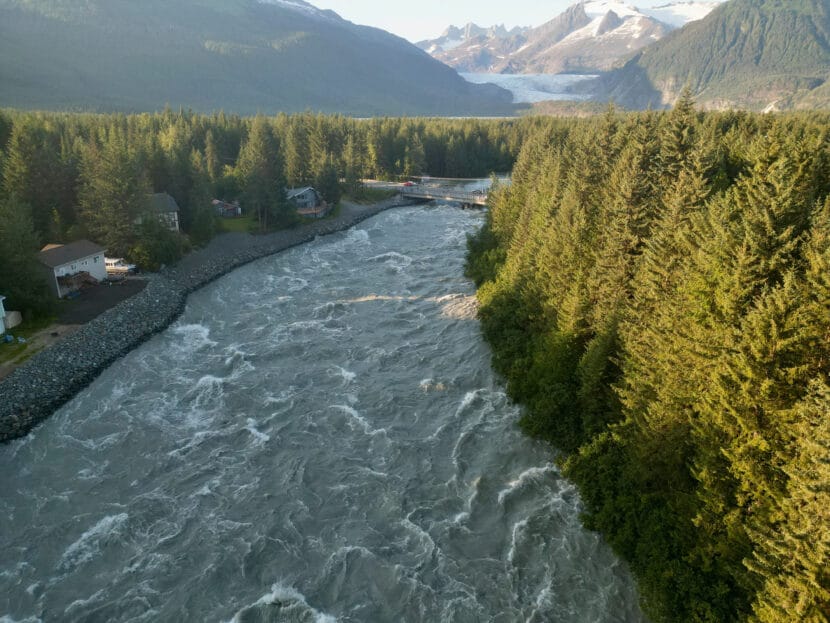
In a special Assembly meeting Thursday, the City and Borough of Juneau introduced phase one of its flood fighting plan.
This comes after August’s record breaking glacial outburst – also known as a jökulhlaup –damaged nearly 300 homes in the Mendenhall Valley.
The Assembly approved an ordinance that will allow the city to work with the U.S. Army Corps of Engineers on the installation of flood protection barriers along the Mendenhall River.
The barriers are made by a company called HESCO. They’re Army Corps–recommended and relatively easy to install, according to City Manager Katie Koester. They’re essentially stackable heavy duty sandbags, which are about 4 feet tall and 3 feet square.
“Those HESCO barriers are what we would be lining the river with to protect life and property in the event of the next jökulhlaup,” Koester said.
The Corps will donate the barriers free-of-charge — enough to eventually line up to four miles of riverbank — along with 60,000 sandbags for individual homeowners. But the city will be responsible for distributing the sandbags and installing the HESCO barriers at key places along the river.
Phase one installation will focus on the stretch from Marion Drive to Killewich Drive to Meander Way. Those locations were selected because that’s roughly where the water first breached the bank in August. Later on, the makeshift levee might be extended along the remainder of the developed side of the river, as well as on River Road and View Drive. The city would take on responsibility for the maintenance of the flood barriers, which typically last for about five years.
It’s unclear what the total project budget will be, but the first phase may cost up to $2 million dollars. The Assembly will discuss ways to come up with that money at a regular meeting on October 21, 2024.
City leaders hope the barriers can be installed over the next few months. In previous meetings, they’ve discussed more long-term solutions to minimize or prevent flooding altogether, but those solutions will be time-consuming, costly and legally thorny. They’ll require a more in-depth study by the Corps. That study has not yet been approved, but Governor Dunleavy and the Central Council of the Tlingit and Haida Indian Tribes of Alaska have requested it and the City and Borough of Juneau have preemptively set local money aside to fund it.
The flood barriers are a more immediate solution, Koester said, though they’re not perfect.
“They’re ugly, they’re large. Again, they’re designed for a five year lifespan,” Koester said. “And while we will be expeditiously looking on long term solutions, we really don’t know what that looks like until, until that study has has been done.”
Most of the barriers will also have to be installed in people’s yards, and about 75 homes may be asked to put barriers on their private property. Koester said the city will start outreach to those homeowners this week, but members of the public who showed up to testify expressed support for the plan.
Some, like Clinton Singletary, who lives in the affected neighborhood of Center Court, also reiterated the need for long-term solutions.
“These events will continue happening as the glacier retreats, and from the research I’ve seen, they’ll likely only get worse each year until effective mitigation is in place,” Singletary said.
Suicide Basin, which is dammed by the Mendenhall Glacier, is bound to flood the valley again. And it’s already refilling, which raised concerns about the possibility of another major flood this fall.
But Aaron Jacobs, a hydrologist with the National Weather Service who attended the meeting, said the basin is only about halfway full and levels in the Mendenhall River are currently low. If Suicide Basin drained right now, it would cause a moderate flood, bringing the river to about 10.5 feet – much lower than record-breaking 15.99 feet during August’s flood.
As freezing temperatures kick in, Jacobs said the possibility of another release in 2024 will wane.
“We’ve never seen one over the wintertime — not saying that couldn’t take place — but just in the past, we have not seen one take place in November, December, January,” Jacobs said. “If it doesn’t release into the fall time, what that will tell us is that we could just see a fuller basin a lot earlier next year.”
The city also plans to welcome the Army Corps of Engineers for a public meeting this fall to provide technical advice for homeowners trying to protect their homes from flooding, but the Corps has not yet confirmed that plan and specific dates have not been announced.
Correction: A previous version of this story misspelled the word “levy.”